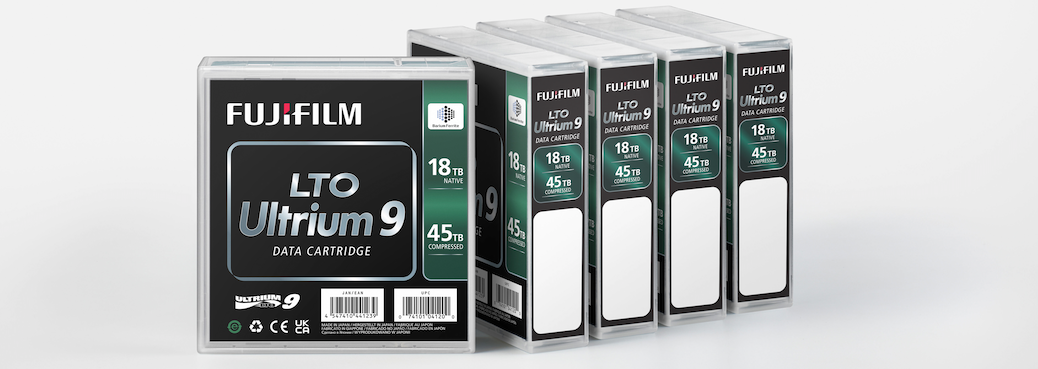Looking Ahead into 2023 for Top 5 Storage Trends
It’s that time of year again to look ahead at what the New Year might bring in terms of data storage. Looking back at our predictions for 2022 to see how well we did, I think we nailed 4 out 5.

It’s that time of year again to look ahead at what the New Year might bring in terms of data storage. Looking back at our predictions for 2022 to see how well we did, I think we nailed 4 out 5.


Sustainability has been a hot issue at all of the trade shows I have attended this year from Data Center World in Austin back in March, to the Sports Video Group Forum in July, to the Flash Memory Summit in August to the Open Compute Summit in October. So it was not surprising that SC22 held in Dallas earlier this month also had a heavy sustainability agenda for its HPC target market.

A new research report on the life expectancy of legacy audio tape was published last month. To me, it speaks to the reliability of tape technology, be it audio, video or data; vintage or modern day. It also reminds me of other research, stories, findings and updates from years gone by and more recently, that ultimately paint an impressive picture in terms of the reliability of tape technology.

After a two year hiatus due to COVID, Fujifilm’s 12th Annual Global IT Executive Summit took place last week in beautiful, warm and sunny San Diego. This year’s Summit theme was “Optimizing storage in the post-Covid, zettabyte age” where organizations have to do more with fewer resources while the value, volumes and retention periods of data continue to increase unabated. It was so good to once again interact face-to-face with members of the storage industry family including around a hundred or so customers, vendors, industry analysts, and storage industry experts during the 3 day event.
About The Summit
For those not familiar with the Summit, it is an educational conference featuring presentations from industry experts, analysts, vendors and end users about the latest trends, best practices and future developments in data management and storage. A concluding speaker panel with Q & A and peer-to-peer networking opportunities throughout the agenda truly make the Summit a unique storage industry event.
Key End User and Vendor Presentations
Similar to past Summits (we last convened in San Francisco in October of 2019) we enjoyed presentations from key end users including AWS, CERN, Meta/Facebook and Microsoft Azure. These end users are on the leading edge of innovation and in many ways are pioneering a path forward in the effective management of vast volumes of data growing exponentially every year.
From the vendor community, we were treated to the latest updates and soon to be unveiled products and solutions from Cloudian, IBM, Quantum, Spectra Logic, Twist Bioscience (DNA data storage) and Western Digital (HDD). The tape vendors shined a light on the continuing innovations in tape solutions including improvements in ease-of-use and maintenance of automated tape libraries as reviewed by Quantum. New tape applications abound from object storage on tape in support of hybrid cloud strategies as explained by Cloudian and Spectra, to the advantages of sustainable tape storage presented by IBM. It’s not a question of if, but when organizations will need to seriously address carbon emissions related to storage devices. After all: “no planet, no need for storage” quipped one attendee. Also included in the tape application discussions were the massive cold data archiving operations as presented by CERN and the hyper scale cloud service providers.
Finally from the world of tape, was a chilling, harrowing tale of a real life ransomware attack experienced by Spectra Logic and how their own tape products contributed to the safe protection of their data with the simple principal of a tape air gap.
Need for Archival Storage
We also heard about the latest updates in the progress of DNA data storage from Twist Bioscience and where the world of HDD is going from Western Digital. We are now firmly in the zettabyte age with an expected 11 zettabytes of persistent data to be stored by 2025. Just one zettabyte would require 55 million 18TB HDDs or 55 million LTO-9 tapes. As an industry we are going to need a lot of archival storage! That includes future technologies like DNA, advanced HDDs, optical discs, and of course, highly advanced modern tape solutions. Tape will continue to deliver the lowest TCO, lowest energy consumption and excellent cybersecurity. All the while tape is supported by a roadmap with increasing cartridge capacities to meet market demand as it unfolds. Certainly, the cloud service providers will leverage all of these storage media at some point as they fine tune their SLAs and prices for serving hot data to cold archival data.

Fred Moore, Horison Information Strategies
Analysts Share Future Vision
From the analyst community, we were treated to a visionary storage industry outlook from Fred Moore, president of Horison Information Strategies who shared the fact that 80% of all data quickly becomes archival and is best maintained in the lower tiers of his famed storage pyramid as an active archive or cold archive. Following Fred was important data from Brad Johns Consulting that showed the 18X sustainability advantage of eco-friendly tape systems compared to energy intensive HDDs. While we need both technologies, and they are indeed complementary, a tremendous opportunity exists for the storage industry to reduce carbon emissions by simply moving cold, inactive data from HDD to tape systems.
Rounding out the analyst presentations was Philippe Nicolas of Coldago Research with some valuable insights into end user storage requirements and preferences in both the U.S. and Europe.
Innovation from an Industry Expert
From the realm of storage industry experts, we had a compelling talk from Jay Bartlett of Cozaint. With his expertise in the video surveillance market, Jay shared how the boom in video surveillance applications is becoming unsustainable from a retention of content perspective. It will become increasingly cost prohibitive to retain high definition video surveillance footage on defacto-standard HDD storage solutions. Jay revealed a breakthrough allowing for the seamless integration of tier 2 LTO tape with a cost savings benefit of 50%! No longer will we need to rely on grainy, compromised video evidence.
Final Thoughts
The Summit wrapped up with a speaker panel moderated by IT writer and analyst, Philippe Nicolas. One big take away from this session was that while innovation is happening, it will need to continue in the future if we are to effectively store the zettabytes to come. Innovation means investment in R&D and production of new solutions, perhaps even hybrid models of existing technologies. That investment can’t come from the vendors alone and the hyper scalers will need to have some skin in the game.
In conclusion, the Summit was long overdue. The storage eco-system is a family from end users to vendors, to analysts and experts. As a family we learn from each other and help each other. That’s what families do. Fujifilm was pleased to bring the family together from around the globe under one roof, for frank and open discussion that will help solve the challenges we and our society are facing.
By Guest Blogger, Dr. Shawn O. Brume Sc. D., IBM Tape Evangelist and Strategist

According to a study by McKinsey, the average lifespan of companies listed in Standard & Poor’s is less than 18 years! That means that tape technology is already in business almost 4 times longer than the average S&P will survive. Tape technology celebrated 70 years young on May 21st. Tape has been and continues to be the most transforming data storage technology in history.
In the 50’s it was the only viable technology for storing data generated by the few computers in existence. In the 60’s tape took the world to the moon and preserved the data for usage nearly 40 years later when it was retrieved to assist in modern space explorations. By the 70’s Tape was dominating storage, transforming the financial industry by providing the ability to access data on accounts with minimal human intervention. The 80’s and 90’s continued the transformation of data availability by performing transactional data storage for ATMs, but also was key in the investigation of the space shuttle Challenger disaster; an investigation enhanced as a result of the durability of tape even when submerged in saltwater.
Today tape lives in the data center, preserving Zettabytes of data. Data being preserved and utilized across nearly every industry, examples:
Healthcare – Data preserved on tape is being utilized to develop new predictive health services. Digital medical records can be retained for the life of patients and shared across organizations.
Financial – Online transaction retention ensures customers valuable financial data is protected in the eventuality of a cyber-attack. Mortgage loans are preserved without fear of tampering.
Cloud – Data stored in public clouds are growing at a 30% faster rate than traditional storage. Cloud providers rely on tape to provide data durability and low-cost storage subscriptions.
Tape’s popularity has often been driven by the low cost of storage, modern data storage requires so much more including cyber-resiliency, data durability and low carbon footprints that enable sustainable IT.
Cyber Resiliency – Tape is the only true airgap data storage solution available.
Data Durability – Tape has a native single copy durability of 11- Nines. This means the likelihood of a single bit failure is 1 in 100 Petabytes.
Sustainability – At scale tape technology is 96% lower carbon footprint than highly dense HDD storage (when comparing OCP Bryce canyon and IBM tape technology with 27PB of data).
If preserving data, in a cyber-resilient solution, at low cost, with relatively low carbon impact meets your business outcomes, then why wait? Clearly tape is here to stay and surging in usage across nearly every business use case.
Happy 70-years to an amazing technology!
For more information about technology since tape’s introduction, check out this post from my colleague Mike Doran.
For more information on current tape products see the IBM product page.

The Tape Storage Council, (TSC), released a new report “Tape to Play Critical Roles as the Zettabyte Era Takes Off,” which highlights the current trends, usages and technology innovations occurring within the tape storage industry. The zettabyte era is in full swing generating unprecedented capacity demand as many businesses move closer to Exascale storage requirements.
According to the LTO Program, 148 Exabytes (EB) of total tape capacity (compressed) shipped in 2021, marking an impressive record year. With a growth rate of 40%, this strong performance in shipments continues following the previous record-breaking 110 EB capacity shipped in 2019 and 105 EB of capacity shipped in the pandemic affected year of 2020.
The ever-increasing thirst for IT services has pushed energy usage, carbon emissions, and reducing the storage industry’s growing impact on global climate change to center stage. Plus, ransomware and cybercrime protection requirements are driving increased focus on air gap protection measures.
As a result of these trends, among others, the TSC expects tape to play an even broader role in the IT ecosystem going forward as the number of exabyte-sized environments grow. Key trends include:
Organizations continue to invest in LTO tape technology thanks to its high capacity, reliability, low cost, low power consumption and strong data protection features, especially as threats to cybersecurity soar.
To access the full report, visit: Tape to Play Critical Roles as the Zettabyte Era Takes Off.

The LTO Technology Provider Companies (IBM, HPE, and Quantum) issued a press release earlier this week announcing record capacity shipments for LTO in 2021 of 148 Exabytes (148,000 Petabytes) compressed (up from 105 EB compressed in 2020, +40%). More and more of the world’s data is being stored on LTO data tape. That’s good news for the IT industry! Is it not? After all, end users and service providers need:
Industry Pundits React
Some industry pundits, biased toward the HDD industry, took the opportunity to downplay the news. They said the data is inaccurate or insignificant compared to the capacity shipments for HDD last year. Really? Does tape technology threaten the market for HDD? Is it still about tape vs. disk in their minds? Have trains, trucks, and ships put air freight out of business? Or does a more strategic thought process say: “These technologies complement each other. We need both to meet the needs of end-users, storage service providers, and society itself…”
Analysts Predict Huge Zettabyte Demand
Indeed, if the big industry analysts firms are right, we will need to be storing more than 11.0 zettabytes of data in 2025. Just one zettabyte would require 55 million 18.0 TB HDDs or 55 million LTO-9 tape cartridges. Should we store all of that data on HDD, whether it is hot, warm, cool, or cold? Of course, we can’t just delete excess data. Now that we can analyze the data and derive a competitive advantage from it, the value of data has increased and we need to store more and more data for longer periods of time. As a result, the projections for the amount of persistent data to be stored are growing exponentially. We will need huge amounts of flash, HDD, tape, and even future storage solutions like DNA to address the data storage challenge.
A Strategic Approach to Data Storage

Change of Attitude Needed
But this is the wrong attitude and exactly what has to change to make a difference. Collectively, if we all switch off a light and all turn the car’s engine off, we will make a difference. We might even get motivated for more change! How about installing LED light bulbs or investing in an electric vehicle? Or maybe make the commitment and take the leadership on a renewable energy installation. Attitudes have to change, believing we can make a difference collectively. If data is inactive, why keep it on energy-intensive, constantly spinning disk? Are we all doing whatever it takes to make a difference?
New Flagship UN Report Is a Wake-up Call
If we believe the latest studies on climate change coming out of the United Nations, we need to start quickly taking any action we can. A new UN report on climate change from earlier this month indicated that harmful carbon emissions in the last decade have never been higher in earth’s history. It’s proof that the world is on a “fast track” to climate disaster. UN Secretary General Antonio Guterres has warned that it’s ‘now or never’ to limit global warming to 1.5 degrees C. Climate change is the result of more than a century of unsustainable energy and land use, lifestyles, and patterns of consumption and production. Guterres adds, “This is not fiction or exaggeration. It is what science tells us will result from our current energy policies. We are on a pathway to global warming of more than double the 1.5-degrees C limit” that was agreed in Paris in 2015. To limit global warming to around 1.5 C (2.7 F), the IPCC report insists that global greenhouse gas emissions will have to peak “before 2025 at the latest, and be reduced by 43% by 2030.”
Reducing Energy Consumption and CO2 Emissions with Tape
To help increase awareness and understanding of energy consumption in data storage, a number of whitepapers have been published highlighting alternative options for storage including LTO data
Other research shows that tape consumes 87% less energy than equivalent amounts of HDD storage. When CO2 emissions are analyzed over the entire product lifecycle (from raw materials to production to distribution, usage, and disposal) of HDD and tape, studies show a 95% reduction in CO2 in favor of tape compared to HDD. The same study shows Total Cost of Ownership for long-term data storage can be reduced by more than 70% by using tape instead of HDD. At the same time, tape can provide an effective defense against cybercrime via a physical air gap. All of this is possible by taking a strategic storage approach, where cool or cold data that has aged and is infrequently accessed gets moved from expensive primary storage to economical and environmentally friendly tape systems, online or offline.
Data Center World Attendees Get It
In my last blog on my visit and presentation at Data Center World in Austin last month, I mentioned that I was encouraged by the DCW attendees that I met and listened to in my session and other sessions. They are genuinely concerned about the environment and worried about what kind of planet we will be leaving behind for our kids and grandchildren. They recognize the opportunity to improve sustainability in data center operations and are committed to it. But since then it has occurred to me that maybe sustainability is more of a focus for facility teams. Perhaps the top-down pressure from the C-suite has yet to be widely applied to the data storage management teams. However, in the quest to achieve the needed sustainability goals, no stone can remain unturned.
Observing Earth Day for Future Generations
With Earth Day being observed today, let’s commit to strategically taking action in response to global warming and climate change. Let’s start changing attitudes from “It won’t make a difference” to “Collectively, we can make a difference.” Let’s look at the bright side of increasing LTO capacity shipments instead of the dark, self-serving side. Let’s think about the planet that’s home for us and the future generations of our families to come.
By Drew Robb, Guest Blogger

The recent release of LTO-9 makes it clear that LTO tape serves the needs of enterprise environments. The cloud hyperscalers and many large organizations are firm believers in LTO tape as the best medium for large-scale storage and archiving.
Despite only being released in early September, tape drives and systems are now available for LTO-9 from the likes of IBM, Quantum, and Spectra Logic. On the media side, companies such as Fujifilm and Sony have launched LTO-9 tape cartridges.
LTO-9 Delivers Capacity and Performance
Fujifilm’s LTO Ultrium 9 data cartridge, for example, offers up to 45 TB of storage capacity (18 TB for non-compressed data), a 50% increase from the previous generation of LTO-8. The boost in storage capacity is achieved using Barium Ferrite (BaFe) magnetic particles, formulated into fine particles with Fujifilm’s Nanocubic technology that evenly distributes the magnetic particles on the tape surface, forming a smooth and thin magnetic layer for improved read/write performance. LTO-9 also delivers high-speed data transfer reaching up to 1,000MB/sec. for compressed data (400MB/sec. native), a 25% increase over LTO-8.
LTO-9 Deployment at CERN
I recently had the opportunity to interview Vladimir Bahyl, a beta LTO-9 user at world-renowned CERN. Vladimir, who is in charge of data archiving at CERN is now rolling out LTO-9 within his storage environment. This is where data from the Large Hadron Collider (LHC) is stored. Massive amounts of data have been generated to date in experiments using a particle collider that measures 17 miles in circumference and is located roughly 100 meters below the France–Switzerland border. Tape has been in use at CERN for about five decades, and the organization currently stores around 400 PB on tape. This enables CERN to keep pace with the data explosion.
After a three-year break for upgrades, the collider is about to recommence operation. The IT department expects up to 180 PB of data to be added in 2022. CERN can cope with that quantity of information courtesy of a sophisticated tape-disk-SSD architecture. All results and all raw data from all CERN experiments are stored on tape and archived. When anything needs to be analyzed, it is transferred to disk and SSD.
Leveraging oRAO for Enhanced Access Time
A feature known as Open Recommended Access Order (oRAO) was included in LTO media for the first time with LTO-9. oRAO enables the retrieval of tape content in a more efficient way. Instead of sequentially laying out data on tape, oRAO takes advantage of multiple serpentine tracks on one tape to arrange data for more rapid access. According to testing at CERN, oRAO can position tape for data access anywhere from 30% to 70% faster than traditional sequential tape. What this adds up to is the need for fewer tape drives for the data recall workflow. If more backup vendors adopt this technology, it could seriously reduce the time needed for a restore.
Benefits of Tape at CERN
Users such as CERN gravitate toward tape for many reasons. In terms of long-term stability, data can still be recovered from tape after 30 years, whereas hard drives struggle to retain data beyond five years. Tape reliability is higher too. CERN has dozens of hard drives failing every week (out of tens of thousands it has on-site) compared to a negligible failure rate for tape.
But economics certainly factor in. Tape brings big savings in terms of CAPEX and OPEX. From an operating expense standpoint, tape consumes no power while tape cartridges are sitting idle, so it’s cost-effective and eco-friendly. The most cost-effective technology for large-scale, long-term storage is tape. And as it offers an air gap, to thwart online hackers, it raises the level of security.
In terms of reliability, the Fujifilm tape used at CERN performed well during a recent tape repacking project to switch older cartridges to the latest tape generation format. Out of 100 PB of tape that was read and repacked (6,300 miles of physical media), only 5 GB (3.5 feet) of data was corrupted – but even those files were recovered soon after.
You can find out more about CERN’s innovative implementation of tape at the upcoming 12th Annual Fujifilm Global IT Executive Summit in San Diego, June 22-24, 2022.
LTO Specs:
| Maximum capacity | 45TB compressed (18TB native) |
| Maximum transfer rate | 1,000MB/sec. compressed (400MB/sec. native) |
| Number of tracks | 8,960 (32 track heads in the serpentine format) |
| Cartridge memory | Internal EEPROM with 32kB electromagnetic induction antenna |
| Tape width | 12.65 mm |
| Tape thickness | 5.2 μm |
| Tape length per cartridge | 1,035 m |

The newly released whitepaper from IT analyst firm ESG (Enterprise Strategy Group), sponsored by IBM and Fujifilm, entitled, “How Tape Technology Delivers Value in Modern Data-driven Businesses,” focuses on exciting, new advances in tape technology that are now positioning tape for a critical role in effective data protection and retention in the age of zettabyte (ZB) storage. That’s right “zettabyte storage!”
The whitepaper cites the need to store 17 ZB of persistent data by 2025. This includes “cold data” stored long-term and rarely accessed that is estimated to account for 80% of all data stored today. Just one ZB is a tremendous amount of data equal to one million petabytes that would need 55 million 18 TB hard drives or 55 million 18 TB LTO-9 tapes to store. Just like the crew in the movie Jaws needed a bigger boat, the IT industry is going to need higher capacity SSDs, HDDs, and higher density tape cartridges! On the tape front, help is on the way as demonstrated by IBM and Fujifilm in the form of a potential 580 TB capacity tape cartridge. Additional highlights from ESG’s whitepaper are below.
New Tape Technology
IBM and Fujifilm set a new areal density record of 317 Gb/sq. inch on linear magnetic tape translating to a potential cartridge capacity of 580 TB native featuring a new magnetic particle called Strontium Ferrite (SrFe) with the ability to deliver capacities that extend well beyond disk, LTO, and enterprise tape roadmaps. SrFe magnetic particles are 60% smaller than the current defacto standard Barium Ferrite magnetic particles yet exhibit even better magnetic signal strength and archival life. On the hardware front, the IBM team has developed tape head enhancements and servo technologies to leverage even narrower data tracks to contribute to the increase in capacity.
The Case for Tape at Hyperscalers and Others
Hyperscale data centers are major new consumers of tape technologies due to their need to manage massive data volumes while controlling costs. Tape is allowing hyperscalers including cloud service providers to achieve business objectives by providing data protection for critical assets, archival capabilities, easy capacity scaling, the lowest TCO, high reliability, fast throughput, low power consumption, and air gap protection. But tape also makes sense for small to large enterprise data centers facing the same data growth challenges including the need to scale their environments while keeping their costs down.
Data Protection, Archive, Resiliency, Intelligent Data Management
According to an ESG survey revealed in the whitepaper, tape users identified reliability, cybersecurity, long archival life, low cost, efficiency, flexibility, and capacity as top attributes in tape usage today and favor tape for its long-term value. Data is growing relentlessly with longer retention periods as the value of data is increasing thanks to the ability to apply advanced analytics to derive a competitive advantage. Data is often kept for longer periods to meet compliance, regulatory, and for corporate governance reasons. Tape is also playing a role in cybercrime prevention with WORM, encryption, and air gap capabilities. Intelligent data management software, typical in today’s active archive environments, automatically moves data from expensive, energy-intensive tiers of storage to more economical and energy-efficient tiers based on user-defined policies.
ESG concludes that tape is the strategic answer to the many challenges facing data storage managers including the growing amount of data as well as TCO, cybersecurity, scalability, reliability, energy efficiency, and more. IBM and Fujifilm’s technology demonstration ensures the continuing role of tape as data requirements grow in the future and higher capacity media is required for cost control with the benefit of CO2 reductions among others. Tape is a powerful solution for organizations that adopt it now!
To read the full ESG whitepaper, click here.

As recently announced by Fujifilm, LTO-9 has arrived and is available for immediate delivery. It certainly comes at a time when the IT industry is so challenged to manage rampant data growth, control costs, reduce carbon footprint and fight off cyber-attacks. LTO-9 is coming to market just in time to meet all of these challenges with the right features like capacity, low cost, energy efficiency, and cyber security.
What a Great Run for LTO
First of all, it is remarkable to look at how far LTO Ultrium technology has come since its introduction. LTO made its market debut in 2000 with the first generation LTO-1 at 100/200 GB native/compressed capacity with 384 data tracks. Transfer rate was just 20 MB native and 40 MB compressed per second. Fast forward 21 years to the availability of LTO-9 now with 18/45 TB native/ compressed capacity on 8,960 data tracks, with transfer rate increasing to 400 MB per second, 1,000 MB per second compressed! In terms of compressed capacity, that’s a 225X increase compared to LTO-1. Since 2000, Fujifilm alone has manufactured and sold over 170 million LTO tape cartridges, a pretty good run indeed.
Capacity to Absorb Bloated Data Sets
We are firmly in the zettabyte age now and it’s no secret that data is growing faster than most organizations can handle. With compound annual data growth rates of 30 to 60% for most organizations, keeping data protected for the long term is increasingly challenging. Just delete it you say? That’s not an option as the value of data is increasing rapidly thanks to the many analytics tools we now have to derive value from it. If we can derive value from that data, even older data sets, then we want to keep it indefinitely. But this data can’t economically reside on Tier 1 or Tier 2 storage. Ideally, it will move to Tier 3 tape as an archive or active archive where online access can be maintained. LTO-9 is perfect for this application thanks to its large capacity (18 TB native, 45 TB compressed) and high data transfer rate (400 MB sec native, 1,000 MB sec compressed).
Lowest TCO to Help Control Costs
Understanding your true total cost of ownership is of vital importance today as exponential data growth continues unabated. The days of just throwing more disk at storage capacity issues without any concern for cost are long gone. In fact, studies show that IT budgets on average are growing at less than 2.0% annually yet data growth is in the range of 30% to 60%. That’s a major disconnect! When compared to disk or cloud options, automated tape systems have the lowest TCO profile even for relatively low volumes of data less than one petabyte. And for larger workloads, the TCO is even more compelling. Thanks to LTO-9’s higher capacity and fast transfer rate, the efficiency of automated tape systems will improve keeping the TCO advantage firmly on tape’s side.
Lowest Energy Profile to Reduce Carbon Footprint
Perhaps of even greater concern these days are the environmental impacts of energy-intensive IT operations and their negative effect on global warming and climate change. You may have thought 2020 was a pretty bad year, being tied for the hottest year on record with 2016. Remember the raging forest fires out West or the frequency of hurricanes and tropical storms? Well, it turns out 2021 is just as bad if not worse with the Caldor Fire and Hurricane IDA fresh in our memory.
Tape technology has a major advantage in terms of energy consumption as tape systems require no energy unless tapes are being read or written to in a tape drive. Otherwise, tapes that are idle in a library slot or vaulted offsite consume no energy. As a result, the CO2 footprint is significantly lower than always on disk systems, constantly spinning and generating heat that needs to be cooled. Studies show that tape systems consume 87% less energy and therefore produce 87% less CO2 than equivalent amounts of disk storage in the actual usage phase. More recent studies show that when you look at the total life cycle from raw materials and manufacturing to distribution, usage, and disposal, tape actually produces 95% less CO2 than disk. When you consider that 60% to 80% of data quickly gets cold with the frequency of access dropping off after just 30, 60, or 90 days, it only makes sense to move that data from expensive, energy-intensive tiers of storage to inexpensive energy-efficient tiers like tape. The energy profile of tape only improves with higher capacity generations such as LTO-9.
A Last Line of Defense Against Cybercrime
Once again, 2021 is just as bad if not worse than 2020 when it comes to cybercrime and ransomware attacks. Every webinar you attend on this subject will say something to the effect of: “it’s not a question of if; it’s a question of when you will become the next ransomware victim.” The advice from the FBI is pretty clear: “Backup your data, system images, and configurations, test your backups, and keep backups offline.”
This is where the tape air gap plays an increasingly important role. Tape cartridges have always been designed to be easily removable and portable in support of any disaster recovery scenario. Thanks to the low total cost of ownership of today’s high-capacity automated tape systems, keeping a copy of mission-critical data offline, and preferably offsite, is economically feasible – especially considering the prevalence of ransomware attacks and the associated costs of recovery, ransom payments, lost revenue, profit, and fines.
In the event of a breach, organizations can retrieve a backup copy from tape systems, verify that it is free from ransomware and effectively recover. The high capacity of LTO-9 makes this process even more efficient, with fewer pieces of media moving to and from secure offsite locations.
The Strategic Choice for a Transforming World
LTO-9 is the “strategic” choice for organizations because using tape to address long-term data growth and volume is strategic, adding disk is simply a short-term tactical measure. It’s easy to just throw more disks at the problem of data growth, but if you are being strategic about it, you invest in a long-term tape solution.
The world is “transforming” amidst the COVID pandemic as everyone has to do more with less and budgets are tight, digital transformation has accelerated, and we are now firmly in the zettabyte age which means we have more data to manage efficiently, cost-effectively, and in an environmentally friendly way. The world is also transforming as new threats like cybercrime become a fact of life, not just a rare occurrence that happens to someone else. In this respect, LTO-9 indeed comes to market at the right time with the right features to meet all of these challenges.
We can help you reduce cost, decrease vendor lock-in, and increase productivity of storage staff while ensuring accessibility and longevity of data.
Contact Us >